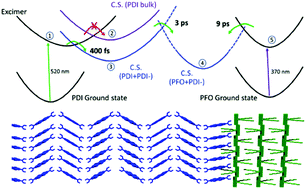Efficient long-range electron transfer processes in polyfluorene–perylene diimide blends†
Abstract
In bulk heterojunction donor–acceptor (D–A) blends, high photovoltaic yields require charge carrier separation to outcompete geminate recombination. Recently, evidence for long-range electron transfer mechanisms has been presented, avoiding strongly-bound interfacial charge transfer (CT) states. However, due to the lack of specific optical probes at the D–A interface, a detailed quantification of the long-range processes has not been feasible, until now. Here, we present a transient absorption study of long-range processes in a unique phase consisting of perylene diimide (PDI) crystals intercalated with polyfluorene (PFO), as a widely used non-fullerene electron acceptor and donor, respectively. The intercalated PDI : PFO phase possesses specific well-separated spectral features for the excited states at the D–A interface. By use of femtosecond spectroscopy we reveal the excitation dynamics in this blend. PDI excitons undergo a clear symmetry-breaking charge separation in the PDI bulk, which occurs within several hundred femtoseconds, thus outcompeting excimer formation, known to limit charge separation yields when PDI is used as an acceptor. In contrast, PFO excitons are dissociated with very high yields in a one-step long-range process, enabled by large delocalization of the PFO exciton wavefunction. Moreover, both scenarios circumvent the formation of strongly-bound interfacial CT states and enable a targeted interfacial design for bulk heterojunction blends with near unity charge separation yields.



 Please wait while we load your content...
Please wait while we load your content...